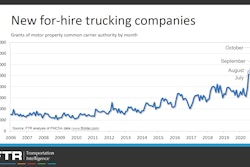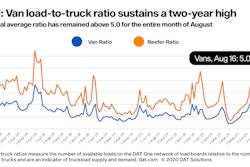Former owner-operator Allan Lester, lately a “semi-retired” ops manager still with a foot in the trucking world, responded to news that longtime Transportation Intermediaries Association head Robert Voltmann was stepping out the side door with a note that might well be best characterized by the sentiment expressed in the headline here.
“Thought I might weigh in on the comments of Mr. Voltmann,” wrote Lester. “While I am fairly certain he will not read this on this platform, maybe the message will be conveyed to the next ‘leader’.”
The comments Lester referred to are Voltmann’s much-viewed, occasionally down-the-nose explanatory video in which he attempts to rationalize the rate environment of late April on the spot market in part by explaining to truckers their power in the supply-demand fundamentals equation. No problem there, Lester contended. If a broker offers an unacceptable rate, “if I don’t like it, I can deadhead back to my customer and try to cover the loss in volume, or I can accept the price to cover my costs and live with it. Getting mad because someone is making more money than me won’t get me anywhere. Know your costs and run your business.”
 Screengrab of Robert Voltmann from his late-April video, which you can find a direct link to via this story.
Screengrab of Robert Voltmann from his late-April video, which you can find a direct link to via this story.Yet along the way, Voltmann in some ways minimized a broker’s role in setting rates, to wit near the very top of his video message with the oft-repeated and deflectionary brokers don’t set prices, the market does.
In abstract terms, Voltmann is correct, given that it’s competition between brokers, and brokers and contract carriers, and between carriers themselves — or lack thereof — that sends rates on average up or down or sideways. But where the rubber meets the road for individual businesses, Lester said, “the statement that brokers don’t set the prices is false. They will post a price for whatever they think they can ‘sell’ the load for. It is not dictated solely by the ‘marketplace,’ or shippers.” In effect, brokers have a principal agency when it comes to price, just as truckers have rates power in that regard, too, whether through turning down offers or service history and a relationship with a particular broker customer.

Lester also objected to Voltmann’s use of the 16% average margin as some kind of panacea for the brokerage space, given per-load percentage takes vary widely broker to broker, and load to load, and “the statement that trucking companies don’t have to invest in technology as the brokers do is hogwash,” Lester added. “Most brokers demand the same technology and access to it. They want tracking and instant communication with either the drivers or the staff 24/7. We all know this. The market has been evolving to this for years.”
Voltmann used a sort of retail analogy in his arguments to me against what he implied was an outdated regulation, 49 CFR 371.3, relative to after-the-fact transparency for the carrier into what the shipper paid for any given load. It’s not an exact analogy, of course, and I didn’t utilize it in my coverage of the issue; others around the trucking-media landscape, however, didn’t hesitate to use similar things themselves. It goes like this: “Do we really need to know exactly what the car dealer paid for the car we bought, or do we need to feel like we bought a car that makes us happy, meets our needs, and at a price we could afford?” he asked. “How is it going to help the carrier if they know what the shipper paid the broker? If the carrier wanted to field their own sales force, they could get 100% of the rate.”
Lester agrees to an extent with this point of view, and also noted Voltmann was “correct is his statement of too many trucks chasing too few loads. … There is no transparency,” he wrote. “We do not get to see what the shipper will pay the broker, and in reality why would we? It’s a free market.”
Yet Lester went on to use a similar retail analogy, deriving from it a much different overall message. “If I go to a home improvement store, they won’t tell me what they paid for a two-by-four. The price is what it is.” Lester takes the buyer’s point of view in the transaction, and when it comes to setting that price, at the point of “sale,” whose agency is dominant? Whoever names the price first, he suggests, and as he noted above, “Know your costs and run your business. But don’t tell me stories and expect I will believe you when we all know the truth.”
Time will tell whether recently named TIA interim CEO Douglas G. Clark, formerly of the Allen Lund Company as well as Greatwide, among others, will hear that message.
What goes around comes around
Remember owner-operator Bill Ater’s idea to go direct from farm to food pantry, one that in a different form turned out to be already offered from farm to family in need direct, with the USDA coordinating the effort? The USDA Farmers to Families Food Box Program, it turns out, showed up real close to home for Ater in Arlington, Texas, he told me recently with these pictures:

 Turns out “I have been volunteering the last two Thursdays at my church handing out these food boxes,” Ater said this past Friday. The Lake Church in Arlington is on Facebook.
Turns out “I have been volunteering the last two Thursdays at my church handing out these food boxes,” Ater said this past Friday. The Lake Church in Arlington is on Facebook.












